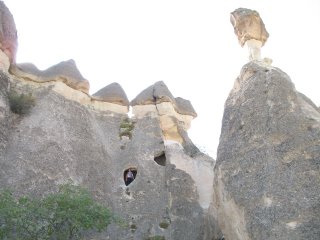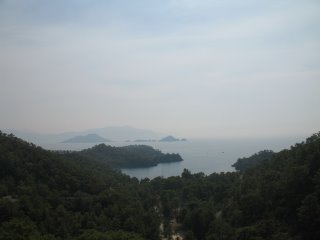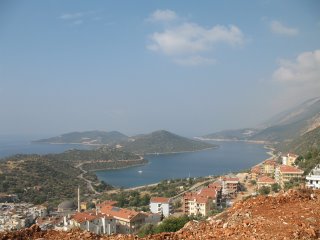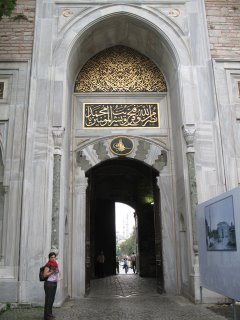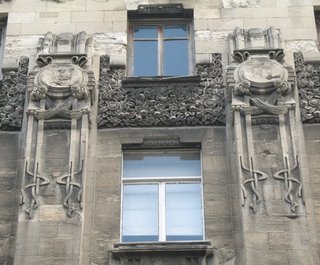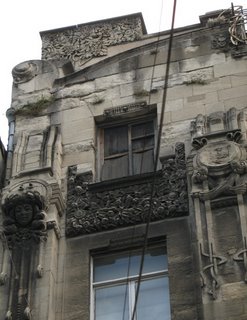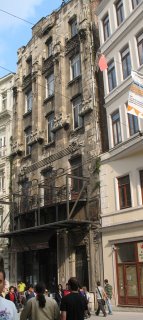We finally crossed over to Iran on Thursday(afternoon) the 26th of October. There was very little hassle at the border. The customs personal were kind and friendly but as expected there were 4 or 5 different hurdles to pass through.
The Iranian motorcycle insurance was 49 Euros for a month, what that covers is any body's guess.
As it was late we stopped over at Maku, 22km from the border.
Next day we left for Tabriz, which is 300km south. Roads could be described as being slightly better than Turkey, with a better finish but the traffic is a challenge and the worse we have seen. Fuel is cheap! about 6-7 Euro cents (or less than 5p) a liter of (95 Ron) petrol
Sunday, October 29, 2006
Saturday, October 28, 2006
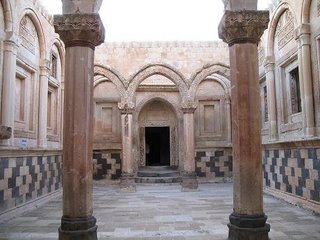
 Ishak Pasa Sarayi, 6km east of Dogubayazit, just above our cabins, is a beautiful 366 room palace/fortress built by a Kurdish chieftain named Ishak in 1784. The gold plated main entrance doors to the palace was nicked by the Russian in the 1st W. War and in a Museum in St. Petersburg now.
Ishak Pasa Sarayi, 6km east of Dogubayazit, just above our cabins, is a beautiful 366 room palace/fortress built by a Kurdish chieftain named Ishak in 1784. The gold plated main entrance doors to the palace was nicked by the Russian in the 1st W. War and in a Museum in St. Petersburg now.
Dogubayazit in the distance is the final Turkish town before crossing over to Iran, real bandit country. Very tatty from outset. 100% kurdish according to the Kurds living in the town (except the army and the police). lots of children on the street as very few attends school. Five wife(s) families with 40 odd children is the common. And town's major source of income is the smuggling (humans, fuel and everything else) across the border.
 10th century Armenian chirch perched on Akdamar island 3km out in lake Van
10th century Armenian chirch perched on Akdamar island 3km out in lake Van
The first most important aspect of Van is that it was a thriving Armenian city until the Turks massacred 1.5 million Armenians between 1915 and 1923 (I'm not quite sure of the true history of this as Turks claims otherwise) and the old city was completely flattened and new dull, ugly city stands 4km from the original city ( not worth a picture!) / La cosa mas importante acerca de Van es que era una ciudad armenia llena de vida hasta que los turcos masacraron 1.5 millones de armenios entre los anos 1915 y 1923 (no sabemos muy bien lo que paso en verdad, ya que los turcos dicen que lo de la masacre es mentira)
Friday, October 27, 2006
Snow-covered mountains of eastern Turkey beyond lake Van / Lago Van con las montanas del este de Turkia, cubiertas de nieve, al fondo.
The first most important aspect of Van is that it was a thriving Armenian city until the Turks massacred 1.5 million Armenians between 1915 and 1923 (I'm not quite sure of the true history of this as Turks claims otherwise) and the old city was completely flattened and new dull, ugly city stands 4km from the original city ( not worth a picture!) / La cosa mas importante acerca de Van es que era una ciudad armenia llena de vida hasta que los turcos masacraron 1.5 millones de armenios entre los anos 1915 y 1923 (no sabemos muy bien lo que paso en verdad, ya que los turcos dicen que lo de la masacre es mentira) .
Armenian church on Akdamar island, 3 km into the lake. / Iglesia armenia en la isla de Akdamar, 3 km dentro del lago.
The Second most significant thing about Van, the next destination of our journey in Turkey is its vast lake 'Golu' largest in Turkey, was formed naturally when flow of local river was blocked by a volcanic activity 2 million years ago and the water is highly alkaline- locals use water for washing with out soap. / La segunda cosa mas importante acerca de Van, la siguiente parada en nuestra viaje a traves de Turkia, es el enorme lago 'Golu', el mayor en Turkia. Se formo de forma natural hace 2 millones de anos cuando actividad volcanica bloqueo el paso natural de un rio de la zona. El agua es altamente alcalina, tanto que se puede lavar ropa con el agua del lago y sale limpia sin necesidad alguna de jabon!.
Saturday, October 21, 2006
Beautiful ancient arabic citiy of Mardin, less than 10km from the Syrian border ( Unfortunatly the entry vias to Syria takes 10 14 days)
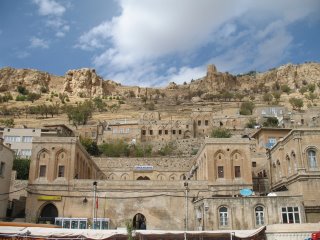 / Mardin, una preciosa ciudad arabe, a menos de 10km de la frontera con Siria.
/ Mardin, una preciosa ciudad arabe, a menos de 10km de la frontera con Siria.
The post office is a restored 11th century Iraqi Selçuk structure / La oficina de correos esta en una casa del siglo XI, de estilo Selçuk.
Entrance to post offıce space at level 1 / Entrada a la oficina de correos en la planta segunda.
 Minarete of main mosque and typıcal façades along Birinci Caddesi - the main street / Minarete de la mezquita principal y algunas de las bonitas fachadas a lo largo de Birini Caddesi, la calle mayor.
Minarete of main mosque and typıcal façades along Birinci Caddesi - the main street / Minarete de la mezquita principal y algunas de las bonitas fachadas a lo largo de Birini Caddesi, la calle mayor.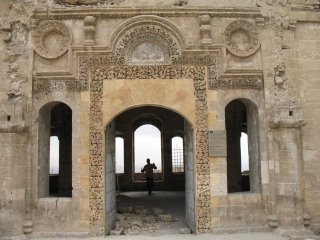 Entrance to 19th century Ottaman army barrcks which are being restored / Entrada a los barracones militares del periodo otoman (siglo XIX), que estan siendo restaurados en estos momentos.
Entrance to 19th century Ottaman army barrcks which are being restored / Entrada a los barracones militares del periodo otoman (siglo XIX), que estan siendo restaurados en estos momentos.
Thursday, October 19, 2006
Diyarbakır. Deep in Kurdish Turkey . People here are proud to be Kurdish and there seems to be little trouble. Police and army presence is not any greater than what we have come across in the rest of Turkey. / Diyarbakır, ya en el centro de la Turkia kurda. La gente aqui se siente orgullosa de ser kurda, no turca, pero no se percibe que haya muchos problemas. La presencia policial y del ejercito no parece mayor que en cualquier otra ciudad turca por la que hemos pasado.
. People here are proud to be Kurdish and there seems to be little trouble. Police and army presence is not any greater than what we have come across in the rest of Turkey. / Diyarbakır, ya en el centro de la Turkia kurda. La gente aqui se siente orgullosa de ser kurda, no turca, pero no se percibe que haya muchos problemas. La presencia policial y del ejercito no parece mayor que en cualquier otra ciudad turca por la que hemos pasado.
The old city centre is surrounded by the remains of a Roman wall more than 6 km in length and with more than 72 towers. / El casco antiguo esta rodeado de una muralla romana de mas de 6 km the largo y unos 72 bastiones.
There is very little tourism here, and the cleanliness of western Turkey is somewhat lacking. Many kids are found on the streets and working at market places rather than at school.
We are now getting used to be subjected to long stares, and the bike certainly pulls the crowds!. People are very friendly and generous despite our inability to communicate in Turkish. / Se ven muy pocos turistas aqui, y los niveles de limpieza son menores que en el oeste de Turkia. Se ven muchos ninos por las calles, y trabajando en los mercadillos en vez de estar en el colegio. Ya nos vamos acostumbrando a que la gente se nos quede mirando embobados, y sobre todo cuando nos paramos con la moto, la gente nos rodea como si nunca hubieran visto algo igual!. La gente es muy amable y generosa, a pesar de que no podamos hablar ni jota de turco.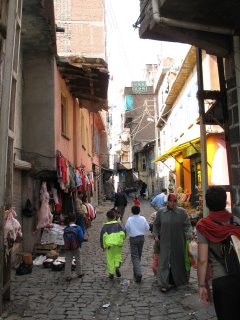

Mayority of motorcycles consist of Chinese copies of 125cc Japanese bikes, Hondas and Yamahas. Most of the larger bikes in eastern Turkey are the surviving Java and MZ that have been modified to include a side car. / La mayoria de motos son copias chinas de motos japonesas, sobre todo Hondas y Yamahas de 125 cc. Gran parte de las motos en el este de Turkia son antiguas Java y MZ a las que se le han anadido sidecares.
Colour coordination Turkish style. There is no lack of neon lighting as well. / Coordinado de colores estilo turco. Tambien las hay con luces de neon tipo 'tuning', para no perderselo!.

Ferry accross the lake on the way from Nemrut Dağı to Şan lıurfa. / El ferry que cogimos para atravesar un lago que hay en la ruta entre Nemrut Dağı y Şanlıurfa.
lıurfa. / El ferry que cogimos para atravesar un lago que hay en la ruta entre Nemrut Dağı y Şanlıurfa.
Balıklı Göl, mosque and madrassa by a pool full of sacred carps. / Balıklı Göl, mezquita y madrasa al borde de un gran estanque lleno de carpas sagradas.
Nemrut Dağı. After riding up the mountain through some scarie roads (steep) we still had to climb on foot 500 m to get to the sumit at 2150m, where the 2 sets of statues (east and west)  were. The Asyrian-looking statues have been dated 1st century BC, and were erected by a megalomeniac king who portraited himself amongst 6 other gods. The stone statues have survived the harsch weather conditions at this altitude very well as can be seen on the pics. The only mishap had been the numerous earthquakes that had toppled the heads off the bodies. / Nemrut Dağı. Despues de conducir montana arriba por carreteras un poco peligrosas (super empinadas) todavia tuvimos que subir unos 500m a pie hasta la cima (que se encuentra a 2150m de altitud), donde se encuentran los 2 grupos de estatuas, unas en el lado este, las otras orientadas al oeste. Las estatuas que tienen un aire asirio, datan del primer siglo a. de C., y fueron eregidas por un rey un poco megalomano que se retrato a si mismo como un dios entre otros 6 dioses. Las estatuas de piedra han sobrevivido muy bien las duras condiciones a las que estan expuestas a esta altitud, tal y como se puede ver en las fotos. El unico percance que han sufrido han sido los numerosos terremotos, que son los responsables de que las cabezas se hayan separado y caido de los cuerpos.
were. The Asyrian-looking statues have been dated 1st century BC, and were erected by a megalomeniac king who portraited himself amongst 6 other gods. The stone statues have survived the harsch weather conditions at this altitude very well as can be seen on the pics. The only mishap had been the numerous earthquakes that had toppled the heads off the bodies. / Nemrut Dağı. Despues de conducir montana arriba por carreteras un poco peligrosas (super empinadas) todavia tuvimos que subir unos 500m a pie hasta la cima (que se encuentra a 2150m de altitud), donde se encuentran los 2 grupos de estatuas, unas en el lado este, las otras orientadas al oeste. Las estatuas que tienen un aire asirio, datan del primer siglo a. de C., y fueron eregidas por un rey un poco megalomano que se retrato a si mismo como un dios entre otros 6 dioses. Las estatuas de piedra han sobrevivido muy bien las duras condiciones a las que estan expuestas a esta altitud, tal y como se puede ver en las fotos. El unico percance que han sufrido han sido los numerosos terremotos, que son los responsables de que las cabezas se hayan separado y caido de los cuerpos.
Friday, October 13, 2006
Göreme, in the heart of Capadoccia, central Anatolia. The surreal landscape is the result of thousands of years of erosion and weathering. Soft volcanic tuff has been sculpted under hard basalt boulders creating 'fairy chimneys'
 . A great number of these have been carved into cave houses, burial grounds, fortresses... and as the 2 images above show a number of beautifully decorated cave churches displayed in the open air museum of Göreme. / Göreme, en el corazon the Capadocia, Anatolia central. El surreal paisaje es el resultado de miles de anos de erosion. Capas de roca blanda de origen volcanico han sido esculpidas bajo trozos de duro basalto creando las llamadas 'chimeneas de las hadas'. Un gran numero de estas chimeneas han sido ademas excavadas por el hombre dando lugar a casas-cueva, lugares de enterramiento, fortificaciones... y, como muestran las 2 imagenes, preciosas iglesias decoradas con frescos. Estas se encuentran en el museo al aire libre de Göreme.
. A great number of these have been carved into cave houses, burial grounds, fortresses... and as the 2 images above show a number of beautifully decorated cave churches displayed in the open air museum of Göreme. / Göreme, en el corazon the Capadocia, Anatolia central. El surreal paisaje es el resultado de miles de anos de erosion. Capas de roca blanda de origen volcanico han sido esculpidas bajo trozos de duro basalto creando las llamadas 'chimeneas de las hadas'. Un gran numero de estas chimeneas han sido ademas excavadas por el hombre dando lugar a casas-cueva, lugares de enterramiento, fortificaciones... y, como muestran las 2 imagenes, preciosas iglesias decoradas con frescos. Estas se encuentran en el museo al aire libre de Göreme.
Thursday, October 12, 2006
Friday, October 06, 2006




Bergama. A very picturesque town, full of very steep streets and friendly people. The greek-roman-byzantine ruins are impressive, to say the least. Perched on the top of a hill overlooking the town centre. The most interesting  remains are those of the 10,000 seat theatre, the steepest of its kind. We spent hours wondering around the ruins; although we were exhausted it was worth the effort.
remains are those of the 10,000 seat theatre, the steepest of its kind. We spent hours wondering around the ruins; although we were exhausted it was worth the effort.
Bergama. Un pueblecıto muy pıntoresco, lleno de cuestas muy empınadas y gente muy amable. Las ruınas greco-romana-bızantınas son ımpresıonantes, estan colgadas de lo alto de la colına desde la que se ve el centro de la cıudad. Los mas ınteresantes son los restos de un teatro romano con capacıdad para 10,000 personas y con la pendıente mas ınclınada de todos los teatros de su clase. Pasamos horas subıendo y bajando entre las columnas y restos de edıfıcıos; aunque termınamos hechos polvo realmente valıo la pena. Some slow traffıc along the way to Bergama (Pergamum) from Bursa.
Some slow traffıc along the way to Bergama (Pergamum) from Bursa.
Trafıco lento de camıno a Bergama (el antıguo Pergamo) desde Bursa.
La cıudad de Bursa - mas de un mıllon de habıtantes. La prımera capıtal del ımperıo Otomano, tıene una precıosa mezquıta toda cubıerta con precıosos azulejos color verde turquesa - la Mezquıta Verde - y un bazar la mar de ınteresante y lleno de hans (grupos de tıendas todas del mısmo tıpo, dıstrıbuıdas alrededor de un gran patıo con una fuente al centro y arboles, al estılo karavanseraı).
Nota- espero que el texto se entıenda a pesar de estar lleno de ies turcas, es que ya estoy harta de cambıarlas una por una!


 Took the ferry from Istambul to Yalova on the way to Bursa.
Took the ferry from Istambul to Yalova on the way to Bursa.Fuımos en ferry desde Estambul hasta Yalova, de camıno hacıa Bursa.


 de Şalıurfa. Ruinas del castillo y vista de las casas-colmena, ahora usadas solo como establos o almacenes.
de Şalıurfa. Ruinas del castillo y vista de las casas-colmena, ahora usadas solo como establos o almacenes.
